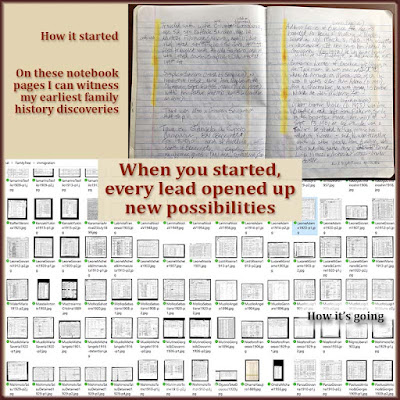If you spend any time on social media, you've seen them. The before-and-after images with the words "how it started" and "how it's going." Usually the joke is that things are not going very well at all.
What if we apply the same idea to our family tree research? How it started for me was a 1989 conversation with my Grandma Leone and a hand-drawn tree of her family. How it's going is a family tree with 32,000 people from all my grandparents' hometowns.
Then I had a conversation with my Grandpa Iamarino. He told me a bit about his sisters. I'd known nothing about them! Now my family tree has his sisters, their children, and generations of their husbands' ancestors.
 |
| "How it started" was a 1989 conversation and a scrap of paper. "How it's going" is a treasure trove of documents and family history. |
Fast-forward to 2002 when my husband-to-be and I were planning our honeymoon in Italy. I wanted to know more about where my ancestors came from. I started with the EllisIsland.org website. I found ship manifests for my two grandfathers. When I noticed that everyone named Iamarino came from one town (Colle Sannita), I took out a notebook. I filled tons of pages with facts about every Iamarino emigrating from Colle.
My husband bought me Family Tree Maker software with a subscription to Ancestry.com. He thought it was time I graduate from the slips of paper I was laying out on the floor to simulate a family tree.
 |
| "How it started" was a notebook filled with info from ship manifests. "How it's going" is a collection of 505 digital manifest images. |
I did indeed graduate. I found my extended family in the census records. Not a single one of my ancestors had come to America before 1890. Our roots here are still so shallow.
My next how it started / how it's going began in about 2006. I learned I could visit a Family History Center at a local church to view microfilm of Italian vital records. For five years, I viewed and documented EVERY vital record (1809–1860) from my Grandpa Leone's hometown of Baselice. I chose his town because I knew almost nothing about his family.
I started this project by finding his parents' birth records in 1850 and 1856. Now I knew their parents' names.
The only way to know my relationship to other Leones in town was to piece together all the families. So I brought my laptop to the Family History Center and typed a line in a text file for each record. Here's an example:
- Pasquale Maria Cernese b 1 apr 1809 to Giovanni di Saverio 35 (bracciale) and Battista di Giovanni Colucci
That's a birth record for Pasquale Maria Cernese, born on 1 April 1809. His father was Giovanni Cernese, a 35-year-old laborer, and the son of Saverio Cernese. His mother was Battista Colucci, daughter of Giovanni Colucci.
 |
| "How it started" was viewing barely-legible vital records by appointment. "How it's going" is a family tree more than 32,000 strong. |
With this type of shorthand, I created a text file that's 29,864 lines long. After each long session at the microfilm viewer, I'd go home and try to work everyone into a Family Tree Maker file. I found a connection to about 15,000 people from the town.
During the entire five-year process, I was yearning to do the same for my Grandpa Iamarino's town. But the visits to the center were a pain. Then, everything changed in 2017. The Italian government published digitized vital records for tons of towns online. Now I can see clear images of the vital records I'd struggled to read on crappy microfilm viewers. Plus, the records don't end in 1860. They go way, way beyond.
And Grandpa Iamarino's hometown vital records are online for me, too! As are my great grandmother Caruso's hometown records. My Grandma Leone's parents' town has very few records online, but they are helpful. And when I discovered two other towns where I have roots, I found their vital records online, too.
Much to my horror, the Italian website completely changed their format today, making it seemingly impossible to download a high-resolution image of your ancestor's document. This stinks! UPDATED: How to Use the Online Italian Genealogy Archives.
For my research, how it started is the five years of squinting at microfilm with a computer in my lap. How it's going is my searchable database of records from my Italian hometowns. And a family tree of more than 32,000 people that's been growing by almost 100 people a day lately.
Why so much growth? Because how it started was asking Grandma and Grandpa about their siblings. How it's going is piecing together the thousands of unions from my ancestors' towns. For instance, I can find the marriage records for my 3rd great grandparents. Then I can find the births of all their children, who their children married, and which kids they had. It adds up fast.
It helps my cause that all my people came from such a tiny footprint on the Italian map. In 2005 my cousins showed me the exact spot where Grandpa Iamarino's house once stood. They pointed out that I could see Grandpa Leone's town in the distance.
A man from one of my towns could meet and marry a woman from one of my other towns. In fact, my 3rd great grandfather Francesco Liguori did just that. He lived in Circello—my one real connection to that town. But he married a woman from the neighboring town of Colle Sannita. They had eight children in Colle, introducing his last name to the town. And that meant I had to explore Francesco's extended family in the Circello vital records.
How did your interest in your family tree start? Think back on your origin story and then ask yourself, "How's it going?"



